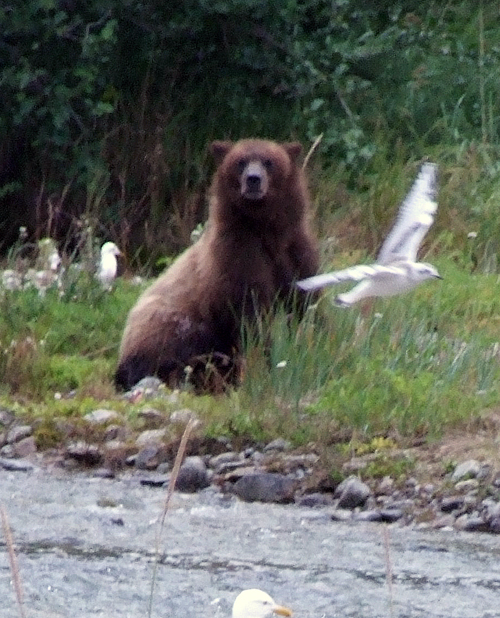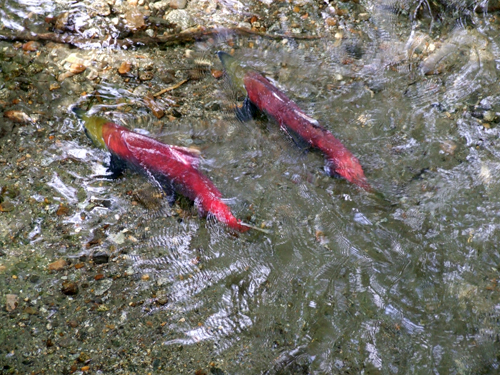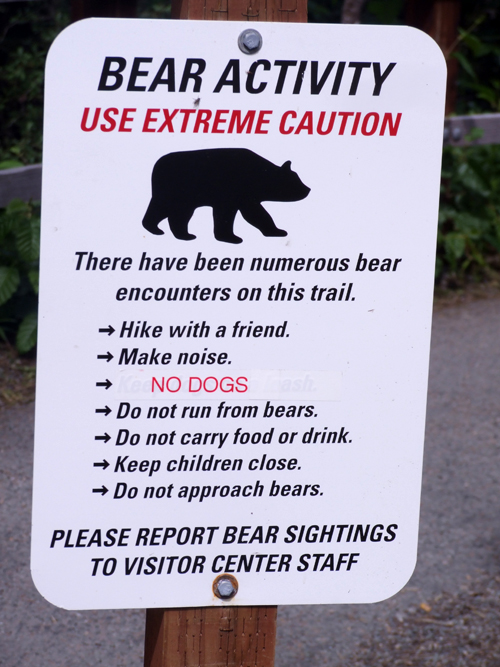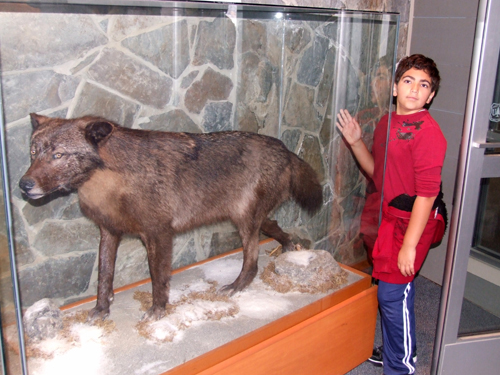By Donald H. Harrison
JUNEAU, Alaska – At the end of a 20-minute drive from the cruise ship terminal to
the visitor center’s parking lot for the Mendenhall Glacier, the MGT bus driver
announced that return trips would leave from that very spot on the hour and the
half hour until the last departure at 6 p.m.
“Bears get kind of hungry about this hour,” he added. “I recommend that you come back by 6 p.m.”
By that time, we already were aware that we would have to “grin and bear” the
jokes from the jovial Mendenhall Glacier Transport driver. Earlier he had told us that food wasn’t
allowed in the U.S. Forest Service-run park. “If you’ve got food and a bear comes after you, I’m not opening the
door,” he warned. “No bears on my bus. You’ve started it, now you deal with it.”
Thus forewarned, we walked to a stream, where there was no wildlife more
dangerous than salmon, which, perhaps dizzy from recently spawning, were
lolling in the shallow waters – clearly easy for anyone to catch with a net,
or, gulp, with its paws.
A Forest Service ranger was standing nearby, so we asked what advice he might
have if we should “happen to see a b-b-bear!”
“Chances are you will be on this elevated walkway, looking down to the ground
where it would be, and for the most part, no matter what situation you are in,
the bear is probably going to ignore you,” the ranger responded cheerily. “We’ve never had a recorded black bear attack
and black bear is what we see here almost all the time.
“As long as you are not drawing attention to yourself, or trying to scare the
bear, or anything like that –-just behaving normally in the way bears are used
to seeing people behave– you will be just fine.”
The ranger also informed us that it is very rare to see brown bears in the area
near the Mendenhall Glacier; that typically it’s the black bears that like to patrol
the waters here.
Grandson Shor wanted to know where he could go to see a wolf – an animal that
fascinates him.
“We do have wolves in the area, but in the three months I am here I have not
seen them,” the ranger said. “I have heard wolves howling on two different occasions—so they are around – but it is
pretty rare to see a wolf. They tend to avoid areas with so many people around. It’s not likely you will see a wolf; it’s more likely that you will see
a bear.”
He was referring to “live” wolves; at the visitor’s center, Shor could examine
up close a stuffed female Alexander Achipelago Wolf that had been killed by
a car in 2003 about a half mile from where we were standing.
At the visitors center overlooking the 12-mile-long
Mendenhall Glacier, a free booklet, Juneau Alaska: 2011 Guide & Travel
Planner informed us about the difference between black and brown bears –
which, counter-intuitively, is not their color.
“The black bear is the smaller of the two bear species in Southeast Alaska,
with adult males weighing 400 pounds or more. A black bear can be distinguished
from the brown or grizzly bear by its straight facial profile. The two types of bears aren’t distinguishable
by color, as black bears in Alaska can be black, brown or cinnamon
colored. The rare blue (or glacier) bears are also a variety of black bear.”
If the bear gets too close, suggested the brochure, “make noise, sing, and clap
your hands.” I remembered the song my parents long ago sang with me to keep me amused on long car trips:
Oh the bear went over the mountain;
The bear went over the mountain;
The bear went over the mountain;
And what do you think he saw?
I wondered whether a bear would take the implied suggestion in that song, or if my
singing would enrage the bear. Maybe, if I had a better singing voice….
The brochure also suggested, “Never approach or follow a bear – always leave it
an escape route. … If you encounter a bear, talk and wave your arms to let it
know you’re a human. A bear standing on its hind legs isn’t threatening you.
Stand your ground. Never try to outrun a bear. Bears may instinctively chase
anything that runs.”
I thought of the old story about the two hikers who encountered a bear. One reached into his back pack to put on a
new pair of running shoes.
“Don’t be ridiculous,” said his friend. “You can’t outrun a bear.”
“I don’t have to outrun the bear,” said the first. “I just have to outrun you!”
As it turned out, we never did see a bear wandering around the Mendenhall
Glacier area. We didn’t spot one until the next day when, with other “adventurers,” we took a field trip
from the Skagway cruise ship port to a zipline course near the former gold mining town of Dyea, due
north of Skagway.

This particular bear had a brown coat and to be honest, I didn’t observe it closely enough to figure out
how straight was its facial profile. From what I could tell, it appeared to be a young bear.
As the ranger at Mendenhall Glacier had predicted, although the bear looked
right at us, it was a lot more interested in the salmon it found in a nearby stream than
in us human creatures. Evidently, the bear concluded that the behaviors we were exhibiting
were normal human behaviors.
As it might have predicted, we held up objects that went “click,” and other objects that went “whirr.”
And we called out to other members of our pack, saying things like, “well, golly, will you look at that?”
and “why didn’t you take extra batteries?” and “mommy, can I go pet it?” and “you most
certainly may NOT!”
*
Harrison is editor of San Diego Jewish World. He may be contacted at donald.harrison@sdjewishworld.com File: US Canada West 14


